Reptile & Amphibian
News Blog
Keep up with news and features of interest to the reptile and amphibian community on the kingsnake.com blog. We cover breaking stories from the mainstream and scientific media, user-submitted photos and videos, and feature articles and photos by Jeff Barringer, Richard Bartlett, and other herpetologists and herpetoculturists.
Friday, November 30 2012
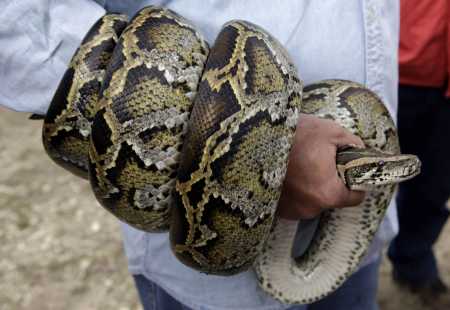 Rep. John Fleming, the chair of the House subcommittee on fisheries and wildlife, led a number of his colleagues in the House in dismissing the idea of adding the reticulated python, boa constrictor, Beni anaconda, DeSchauensee's anaconda, and the green anaconda to an existing rule banning the importation and interstate sale of four other species of snake. The committee held a hearing yesterday on the proposed ban, H.R. 511.
From the Tampa Bay Times:
Their staunch opposition greatly diminishes the chances that Congress will approve a bill to broaden the ban on invasive snakes that was proposed by U.S. Rep. Tom Rooney, R-Tequesta, and supported by proponents of Everglades restoration.
Opponents cited evidence that these snakes die in cold weather and cannot move farther north to threaten other parts of the country. They said a nationwide ban on importation and interstate sales would thwart pet owners and pinch the livelihoods of sellers and breeders.
"Florida is handling a Florida problem that only exists in Florida," U.S. Rep. John Fleming, R-La., chairman of the House subcommittee on fisheries and wildlife, told witnesses at a hearing on Thursday.
[...]
A Florida member, U.S. Rep. Steve Southerland, R-Panama City, dismissed the proposed ban as "a solution in search of a problem." He said the bill amounts to an egregious attempt by an overbearing government to rein in helpless small businesses, jeopardizing a $1.4 billion reptile industry.
"I'm dumbfounded," Southerland said. "We got bigger fish to fry here than to target businesses. It's open season on businesses. It's open season on enterprise, on freedom."
To go into force, the bill would have to be approved by the committee, then pass the full House, a Senate committee, and the full Senate, all before Congress closes shop for the year in mid-December.
Read the full story here.
Photo: Tampa Bay Times
Thursday, November 29 2012
By
Thu, November 29 2012 at 22:47
Well, I might as well have a kingsnake.com account since I frequent here. My name is Emily, and I consider myself an amateur herpetologist. Although I am younger, I have worked with reptiles since the age of 6 and a half. There I met my best friend and boyfriend, Adam, who will probably do entries as well. Together, we own currently, 28 and a half (we put a deposit down) reptiles. Yes, 28, although I'm sure that isn't unusual here haha. Starting on the first of December, I'll start introducing our reptiles. 
Cheers!
-Emily
Wednesday, November 28 2012
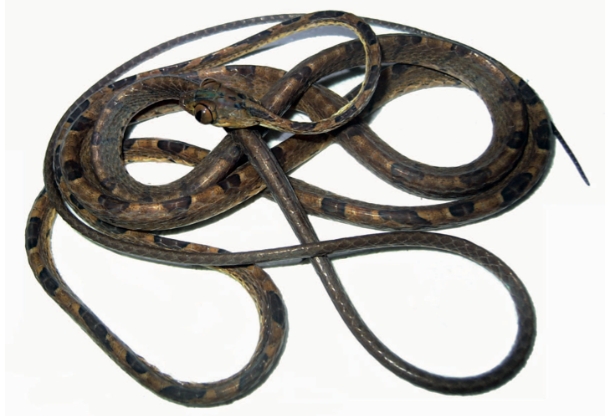 Scientific American reports a new species of snake Scientific American reports a new species of snake, Imantodes chocoensis, has been identified in the tropical region of Chocó:
Discovered by a group of zoologists led by Omar Torres-Carvajal from the Museo de Zoología QCAZ in Ecuador on 24 April 2007, I. chocoensis was described based on several live individuals and preserved specimens that have been sitting in a number of Ecuadorian and American natural history museums, unidentified since 1994. Also known as the the Chocoan blunt-headed vine snake, it was distinguished from its relatives through an analysis of its DNA, morphological features, and colour patterns. Read more...
It's like an Onion story, but it's real life. Police raided an indoor pot growing facility in Washington State, only to find it being guarded by alligators. Also present: An exotic pole dancer and her pole. The cops put the gators in a tub, and fed them some raw chicken before removing them. No, really. This happened. Read more...
Charles Darwin predicted it, and modern GPS technology proves it: The Galapagos giant tortoise sure gets around:
[S]cientists with the Max Planck Institute for Ornithology and the Charles Darwin Foundation have used GPS technology and 3-D acceleration measurements to find out that the dominant male tortoise will wander up to 10 kilometers into the highlands of the island - but only the fully grown animals migrate, the young tortoises stay in the lowlands.
Why? And why don't they rest during the dry season? It's a Chelonoidis nigra mystery of science.
Charles Darwin anticipated that the giant tortoises wandered large distances. In the cool dry season, the highlands of Santa Cruz are engulfed in fog which allows the vegetation to grow despite the lack of rain. In the lowlands, however, there is no thick layer of clouds and the tortoises' vegetation is not available year round. Adults, which can weigh up to 250 kilograms, spend the dry season in the higher regions at an elevation of 400 meters above sea level. However, since the food is not as nutritious there, they trek back to the lower zones where there is succulent vegetation, as soon as the rainy season begins. Read more...
Tuesday, November 27 2012
 With the hearing on H. R. 511 and the release of a new report questioning the conclusions of the original USGS study this week, yesterday National Public Radio's (NPR) All Things Considered wrote about the issue and interviewed some of the players in the on-going saga of the Burmese python in South Florida.
NRAAC panelist Dr. Elliott Jacobson, National Geographic Society resident herpetologist Dr. Brady Barr, and Dr. Gordon Rodda, author of the original USGS study (now retired) all spoke to NPR. Although most of their statements did not appear to make the interview's final cut, those that did are very brief and very specific.
Jacobson says pythons have trouble eating and digesting food at temperatures below 60 degrees. "The bottom-line conclusion was the number of freezing days in the winter is going to limit the ability of this animal to spread beyond extreme South Florida," he says.
To read the article please check out NPR's website, or listen to the story and interviews here.
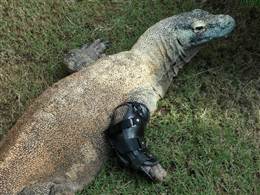 Ivan the Komodo dragon suffers from arthritis. So veterinarians and zookeepers at the Phoenix Zoo recruited the same company that made a prosthetic tail for a Florida dolphin, Hanger Prosthetics and Orthotics, to rig up a prosthetic device to help him get around without pain.
They got to work, and created a custom splint for Ivan at no charge.
The splint has worked to improve Ivan's mobility, as you can see on this video from NBC News here.
Monday, November 26 2012
 When Lonesome George died last June, he was thought to be the last of his kind, the Pinta Island tortoise ( Chelonoidis nigra abingdonii). Now scientists are saying that, given the will, a little effort, and a hundred or 150 years, they can revive the lost subspecies. From ABC News:
Researchers say they may be able to resurrect the Pinta Island subspecies by launching a cross-breeding program with 17 other tortoises found to contain genetic material similar to that of Lonesome George, who died June 24 at the Pacific Ocean archipelago off Ecuador's coast after repeated failed efforts to reproduce.
Edwin Naula, director of the Galapagos National Park, said in a telephone interview on Thursday that the probability is high it can be accomplished.
"It would be the first time that a species was recovered after having been declared extinct," Naula said.
But it won't happen overnight.
"This is going to take about 100 to 150 years," Naula added.
Scientists took DNA samples from 1,600 tortoises on Wolf volcano, and found the Pinta variety in 17, though their overall genetic makeup varied.
Through cross-breeding, "100 percent pure species" can be achieved, said Naula, a biologist.
Read the whole story, and view video, here.
Photo of Lonesome George in 2006 by Mike Weston, licensed under the Creative Commons Attribution 2.0 Generic license.
hello all.
i am very excited to share the process of making a pretty unique terrarium. i have been taking photos of the building stages and they will be posted shortly. i hope you enjoy watching my ideas come to life with me 
this cage is for a Dumeril's Ground Boa i bought as a small baby five years ago named Fleep. (My son named it, lol)
Check it, people!
Friday, November 23 2012

If you're like most people, you're still having trouble working off the mashed potatoes and pie from yesterday, and are planning to spend the weekend on the couch watching football, eating leftovers, and enjoying the holiday with family and friends. Instead of fighting the traffic and crowds at the mall to take advantage of this weekend's sales, why not sit back, relax, have another cup of eggnog, and keep yourself warm checking out all the hot holiday deals in kingsnake.com's classifieds?
Casey Lazik is just one on the many longtime kingsnake.com classified vendors offering special deals, like this unusual Female Pastel Clown Ball Python, among others.
With reptile and amphibian vendors from around the world posting ads, kingsnake.com's classified are full of Black Friday and Cyber Monday deals on everything from cages and supplies to reptiles and amphibians -- something for virtually every herper's Christmas list!
Or, if you're a vendor with some hot holiday gift ideas to fill a reptile lover's Christmas stocking, then post your own!
To see all the Black Friday deals in the kingsnake.com classifieds, click here.
To check out the upcoming Cyber Monday deals, click here.
To register for a classified account and post your own holiday deals and offers, click here.
Thursday, November 22 2012
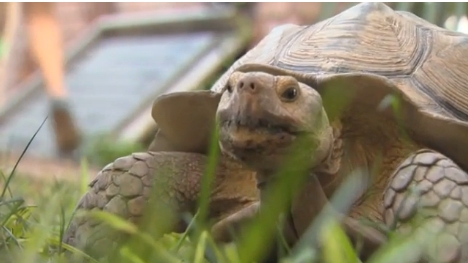 Thanksgiving stories just don't get much better than this. A pet Sulcata tortoise, who had been missing for months, was re-united with his family in time for the holiday, thanks to the power of social media and the mayor of a nearby Texas town.
From KVUE in Austin:
For the past several months Donna had posted fliers about her missing pet Tortoise, a 40 pound African Sulcata she named John Wayne who escaped from her backyard when he broke through a metal gate.
Little did she know, weeks later and miles away in San Marcos, someone had seen the wandering tortoise and turned him into an Animal Rescue.
San Marcos Mayor Daniel Guerrero who is also a pet lover adopted the tortoise and brought him home.
Through the power of social media, Guerrero had also posted pictures of the new addition to his family.
Different circles of Hays County residents who had seen the fliers and Facebook pictures began to put two and two together.
Three months after he disappeared, “Leonard” as he was named at the Animal Rescue was reunited with his rightful owner Donna.
Read the whole "awwww"-inspiring story here! And Happy Thanksgiving!
Wednesday, November 21 2012
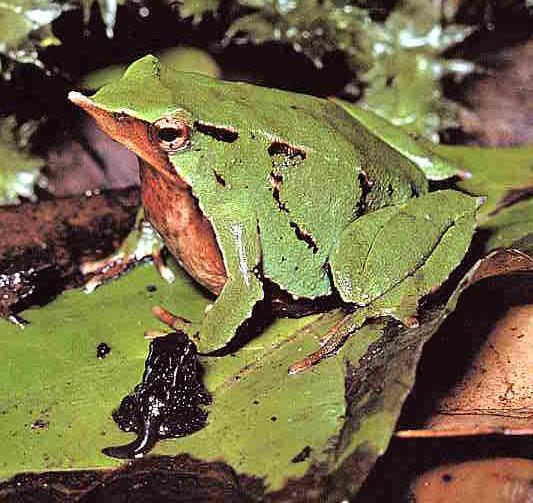 Tired of cute and cuddly animals getting all the attention Tired of cute and cuddly animals getting all the attention -- and the conservation efforts, too? So is the Zoological Society of London, which is "trying to bring attention to distinct and endangered animals like the olm, a translucent cave amphibian that can live 100 years, and western long-beaked echidnas, which are mammals that lay eggs.... The society ranks endangered mammals, amphibians and birds based on their evolutionary distinct characteristics in order to raise awareness and to begin conservation programs." Read more...
Can the world's business community turn around devastating habitat destruction and save threatened species? "A quarter of the world's mammals, 13% of birds, 41% of amphibians and 33% of reef-building corals are now at risk of extinction," reports the Guardian in a lengthy, in-depth examination of the concept of "natural capital," and the financial benefits of preserving species and habitats. Read more...
It's the largest release of threatened sea turtles in the Caymans in years... but is it a good thing, or bad? CayCompass.com digs into the roots of the controversy:
Last weekend’s event featured the largest number of turtles released in years, as the breeding farm facility and major tourist attraction in West Bay reported a record number of eggs laid and an increased hatching rate. One by one, and in steady succession, captive-bred farm-raised turtles were off-loaded from a truck that delivered them from the Turtle Farm to the beach adjacent to North Sound Golf Club and then carried to water’s edge by eager participants and placed in the sand to be taken into the warm Western Caribbean Sea by the surf.
“Standing here at the seaside, releasing a fresh group, is the ultimate expression of the Cayman Turtle Farm’s conservation mission,” said Tim Adam, managing director of the Cayman Turtle Farm: Island Wildlife Encounter. “As these baby turtles cross the sand, enter the water and start new lives in the sea – it is an awesome moment that gives us hope for the future. Hope that the wild population will continue to grow and flourish with our help."
[...]
The Turtle Farm hasn’t been without its critics though – especially of late.
The Florida-based Sea Turtle Conservancy and the London-headquartered World Society for the Protection of Animals have urged the Cayman Turtle Farm in recent months to stop farming a species designated as endangered. Critics also say there is limited evidence that the release programme has helped grow turtle populations over the years and suggest releasing farmed turtles could pass on diseases to the species in the wild.
Earlier this year, WSPA released a scathing investigation claiming the Turtle Farm had failed to meet baseline welfare criteria by citing video and photographs purporting to show turtles in overcrowded and dirty tanks, as well as turtles missing fins, sporting various injuries, and even one left blind by congenital defects. The advocacy group maintains that some of the sea turtles have resorted to cannibalism in their enclosures and may pose threats to humans by potentially passing on E coli, salmonella and enterococci to visitors who handle and interact with the creatures at the tourist facility.
Read more...
Photo: Darwin's Frog from WTOP/San Francisco State University.
Monday, November 19 2012
 The most popular kids' show on PBS is going to feature Australian animals and the late Steve Irwin's 14-year-old daughter, Bindi.
From Gather.com:
Curious George is going to Australia for his seventh season premiere, and while he's there, he's going to learn about Australian animals from none other than Bindi Irwin, the daughter of the late Crocodile Hunter, Steve Irwin.
When the monkey and The Man in the Yellow Hat go to Australia, George finds giant footprints in the sand. What can they be? Bindi Irwin helps him find out about that, and about kangaroos, koalas, emus, and more, according to an article at TV By the Numbers.
The episode, titled "Monkey Down Under," starts a whole season of animal-themed shows in which the monkey will learn about all sorts of mammals, birds, insects, and reptiles.
"I was so excited to be a part of Curious George," says Irwin in the article. "He's my favorite monkey, I've loved him my whole life. It's wonderful he could help me teach kids about the beaut bonza animals that live around my home at Australia Zoo."
Read the whole story here.
Photo of Bindi Irwin at the TV Week Logies 2011 by Eva Rinaldi, licensed under the Creative Commons Attribution-Share Alike 2.0 Generic license.
Thursday, November 15 2012
 The Galapagos Islands, home to some of the world's most unusual and endangered herpetofauna, will be targeted with 22 tons of specially-designed poison baits in an effort to combat the chain's estimated 180 million rats.
The Galapagos, or Archipiélago de Colón, are an archipelago of volcanic islands distributed around the equator in the Pacific Ocean 525 nautical miles west of continental Ecuador, and form an Ecuadorian province, a national park, and a biological marine reserve that are home to the Galápagos land iguana, Conolophus spp., Marine iguana, Amblyrhynchus cristatus, the Galápagos giant tortoise, Chelonoidis nigra, and the Galápagos green turtle, Chelonia mydas agassisi.
From the Associated Press / NBC 6 South Florida:
"It's one of the worst problems the Galapagos have. (Rats) reproduce every three months and eat everything," said Juan Carlos Gonzalez, a specialist with the Nature Conservancy involved in the Phase II eradication operation on Pinzon island and the islet of Plaza Sur."
Geologically young and famed for their vast number of endemic species, which were studied by Charles Darwin during the voyage of the Beagle, many observations and collections made in the Galapagos contributed to the inception of Darwin's theory of evolution by natural selection.
A helicopter is to begin dropping nearly 22 tons of specially designed poison bait on an island today, launching the second phase of a campaign to clear out the invasive Norway and black rats, introduced by whalers and buccaneers beginning in the 17th century. The rats feed on the eggs and hatchlings of the islands' native species. To read more, see the complete article here.
(Gallery photo posted by Ivory Tortoise)
Wednesday, November 14 2012
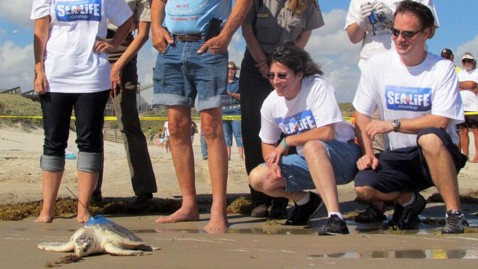 A heartwarming story about the endangered Kemp's Ridley sea turtle -- with an international twist.
From ABC News:
They named her Flip — a Kemp’s Ridley sea turtle found last December, stranded on the coast of Holland. She was injured and stunned by the cold.
But the scientists and animal lovers who rescued her took advantage of a key fact about Kemps’ Ridleys — that while they’re endangered, they are also among the world’s great long-distance travelers. Specialists nursed her back to health, and released her into the water today — off the coast of south Texas.
“We couldn’t have asked for it to go any better,” said Iain Scouller, the general manager of Sea Life Aquarium Grapevine, based near Dallas-Fort Worth. “We set her loose at high tide, and off she went.”
Read the story -- and watch video of the release -- here!
Tuesday, November 13 2012
Hey all. At the expo last weekend I got a Pygmy chameleon. The breeder claims it as a male but I have seen websites showing pictures like him as a male and female. Any help? Figured there might be someone here that owns and breeds them. I want to know so I can get another soon if all goes well. I'll try to get a picture on here soon.
P.S. It is R. Temporalis
 Where on your post-rattlesnake bite to-do list is "update Facebook status"? For a California teen who nearly died from six rattlesnake bites, it was right after "get in car to go to hospital."
From ABC News:
(Sixteen-year-old Vera Oliphant) said she was in a fog, her eyesight and her consciousness fading. How she got to the house, she cannot fully recall. “I was feeling numb and paralyzed. I had black vision and I saw bubbles. It felt like needles were stabbing me… it burned so hard and it felt like a bomb just exploded in me. It’s really hard to describe,” she said.
“I struggled to get my key out, and I was too weak to ring the bell. I desperately tapped at the window and cried, ‘Help me,’ and that’s when my uncle took me to a hospital 15 miles away,” said Oliphant.
On the way to Sharp Grossmont Hospital in La Mesa, Oliphant was somehow able to put a post on her Facebook page: “i got bit by a rattle snake & now i,m about to go to l.C.U .. it hurts like a ___ & my leg is paralyzed ._.”
Soon after, she went into anaphylactic shock twice and lost consciousness four times. She arrived at the hospital in the nick of time.
What's next, a Tweet saying, "Am being mauled by lions. Hurts. #shouldneverhaveclimbedintothebigcatenclosureatthezoo"?
Monday, November 12 2012
This day, while we are honoring those that fought for our freedom, lets not lose sight of the fact that the fight for freedom continues everyday, both abroad and domestic.
The Future
As you wake up with the morning , the sun on your face, your stomach growls with hunger so you get out of bed and make your way downstairs to the kitchen to make some breakfast. You pull some ingredients out of the fridge and begin to prepare and cook. As you smell the aroma of the slab of garden burger with soy cheese, sizzling in the pan and banana muffin in the toaster oven, you begin to reminisce about a breakfast of eggs, bacon, sausage, ham, and a tall glass of milk…none of which you can ever eat again. As you sit and eat your drab breakfast, you grab your tablet to read the latest news. You still find it difficult to navigate through the local news webpage on this thing and just wish you could hold a printed newspaper again. The headline article you see show’s a picture of a squadron of law enforcement cars in front of a house, a man laying face down with his hands behind his head in the front lawn, surrounded by what looks like a swat team, weapons drawn and pointed at the man. Another person you see walking into the house, thick with body armor from head to toe. The caption reads “Man found harboring illegal canines, now faces life in prison”. You look over to the counter and see the picture of you with your dog, Chewy, from years before and tears fill your eyes as you remember your companion of 10 years that was taken and euthanized, well before his time. You try to choke down your breakfast but find it difficult between the plain food and the lump of emotion in your throat.
Well, it’s time to get ready for work…so you go get dressed in your synthetic fiber pants and shirt with your wool-free socks and sweater, grab your synthetic non-leather briefcase, get into your Karma hybrid, leather-free car and head off to work. Luckily, you are driving very slow and cautious to avoid the wildlife on the road. You see flashing lights up ahead and proceed with care. As you drive by, you notice a car off to the side of the road with the front end damaged and windshield cracked. You see a dead young deer about 50 feet in front of the car and the driver is handcuffed in the back of the police car. You think to yourself, glad that isn’t me because it is a minimum 1 year in jail and $5,000 fine for injuring or killing an animal on the roadway.
You arrive at work and because you didn’t eat most of your breakfast, you can’t wait till lunch time. Fast forward, It’s lunch time and your starving so you leave immediately. You decide to spoil yourself with a much deserved treat, and head over to a local restaurant that, if you know the right people, will sell you a hamburger. Of course, that hamburger will cost you $60 because they are illegal. As you drive into the parking lot, you notice that it is empty. You walk up to the door where you see a big notice posted stating that this establishment has been condemned and is scheduled for demolition after being found in violation of the Animal Consumption Act. The ACA makes the consumption of all Animal parts and byproducts illegal and violation of any part of the act is a felony. The ACA is a measure that was proposed by SHELA, (Society for the Humane and Ethical Liberation of Animals, a collaborative organization comprised of multiple Animal Rights Organizations). This measure was controversially passed and is enforced by SHELA-LE, a federally mandated, law-enforcement branch of this organization staffed with government appointed officers from all branches of law enforcement and the military.
Well damn, It looks like it is off to a fast-food drive thru for another Tofurky sandwich with tomato, lettuce, and Vegenaise.
By the end of the day, your body aches from sitting in front of the computer all day, your head hurts and your eyes strained from looking at the monitor. Sometimes, you just wish you could work with a stack of papers again instead of this blasted computer, but paper is now a very rare commodity due to the heavy taxation put on it thanks to environmental groups.
You had to work late and know you have a long, cautious drive home due to flourishing deer populations, now that hunting is banned in the United States.
You finally make it back home and your stomach is in knots from hunger so you go straight to the kitchen. You are sick of eating fruits and vegetables and tofu, but you have no choice. You walk over to the counter to grab an apple in the bowl right next to that picture of you and Chewy your faithful canine companion. Your face turns red from anger as you remember the details of the day that SHELA-LE pulled into your neighborhood with their caravan of “Death Wagons” as most people referred to them. You are outraged knowing that you had registered Chewy with your local Animal Control, like a good responsible citizen. Once the federal laws were passed outlawing the captivity and enslavement of all living creatures, you knew it was only a matter of time before they came for your best friend. They came and knocked on your door, you sat there holding Chewy, praying they would leave if they thought you weren’t home. Chewy let out a bark….and then you heard the man at the door request the battering ram to enter the premises. You reluctantly opened the door and began to berate the people standing on the front step, calling them soul-less monsters and the devils minions. They were not even fazed by your outrage and ordered you to step aside or be arrested for obstruction. They barged their way into your home to seize your pet. You hear the screams and cries of your neighbors as other SHELA-LE teams are forcing their way into homes and taking their animals too. Chewy, barking at the strangers entering his domain, is violently noosed and dragged out of the house, to the vehicle waiting in front. You were frozen at the thought that anyone could so coldly break the bond you built with this animal for 10 years and emotionlessly kill another living creature. You were so overcome with rage and fear, you couldn’t even speak to say goodbye to Chewy. Before you know it, he’s loaded into the back of the wagon and you know that he is dead before they even drive off to the next house.
The pain is just as real now as it was then. You feel a puncturing, stabbing pain, you feel light headed, sick to your stomach, and a hot flush rushes through your body as though you had spontaneously combusted. As the tears stream down your cheeks and the ache envelopes your heart, you wonder to yourself…how did the world come to this? How did these organizations come to such great power and the government become their puppets? You think back to 15 years ago, when you saw posts all over Social Media of people with exotic animals begging for help to defeat laws banning exotic pets which, if passed, would force them to give up their beloved pets. Did the same things happen to them as happened to me and my Chewy? Could they possibly have felt the same pain when their exotic pets were taken away and destroyed? They said they would be coming after our dogs and cats next, and after agriculture and hunters, but you didn’t believe them. Instead, you believed all the scary news reports and articles telling you that they are trying to protect you and save the animals from horrible situations, the same things they said later about my Chewy which couldn’t have been farther from the truth. You realize that you have no one to blame but yourself for believing all the hype of these extremist organizations, and for not doing something more to stop it back when you still had the opportunity.
J. Potash
Thursday, November 8 2012
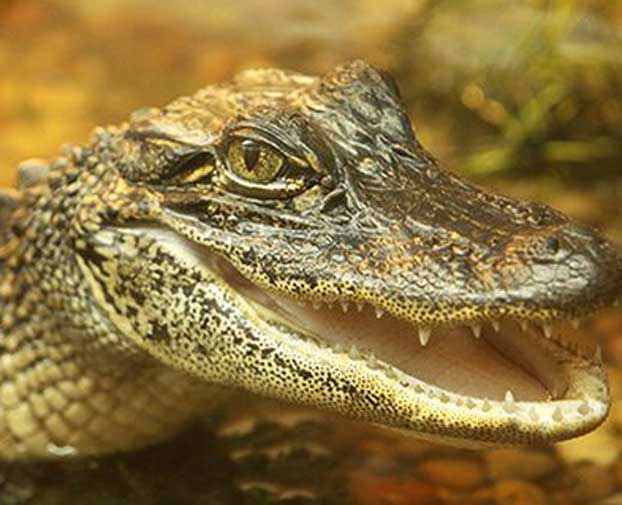 "Sensitive" is probably not the word that springs to mind when you think of a crocodile's jaws, but it turns out they're more sensitive to vibration and touch than a human fingertip.
From a Discovery report on a study in the Journal of Experimental Biology:
"We didn't expect these spots to be so sensitive because the animals are so heavily armored," co-author Duncan Leitch said in a press release. Leitch, a graduate student, performed the studies under the supervision of Ken Catania, a professor of biological sciences at Vanderbilt University.
The technical name for the spots is "integumentary sensor organs" or ISOs. Scientists over the years have speculated that they held all kinds of functions, from secreting oil to detecting electrical fields. A study in 2002, however, suggested that they detected ripples made by water, so that led to the latest research.
"This intriguing finding inspired us to look further," Catania said. "For a variety of reasons, including the way that the spots are distributed around their body, we thought that the ISOs might be more than water ripple sensors."
Read the full story here.
Wednesday, November 7 2012
 The 36th International Herpetological Symposium has announced the first confirmed speakers for its 2013 event, to be held in New Orleans, Louisiana, July 31-August 3 at the Astor Crown Plaza.
With three days of presentations on herpetology, herpetoculture, and reptile veterinary medicine, the symposium is in its 36th year of connecting hobbyists, scientists, educators, and zoo professionals. Confirmed speakers for the 2013 event so far include noted herpetologists and herpetoculturists Charlie Painter, John Cann, Danté Fenolio, Ph.D, Tell Hicks, Vince Scheidt, Fred Antonio, Steve Reichleing, Ari Flagle, Ed Pirog, and Karl Switak. I am also scheduled to speak at IHS 2013, and will be discussing the NRAAC organization and its annual reptile and amphibian law conference. Attendees of this educational event will receive free admission to the amazing Audubon Zoo, the Aquarium of the Americas, and the Audubon Butterfly Garden and Insectarium
For up to date information on scheduling, hotel accommodations, and to register to attend, please visit the IHS at their brand spanking new web site at http://www.internationalherpetologicalsymposium.com.
See you on Bourbon Street!
Monday, November 5 2012
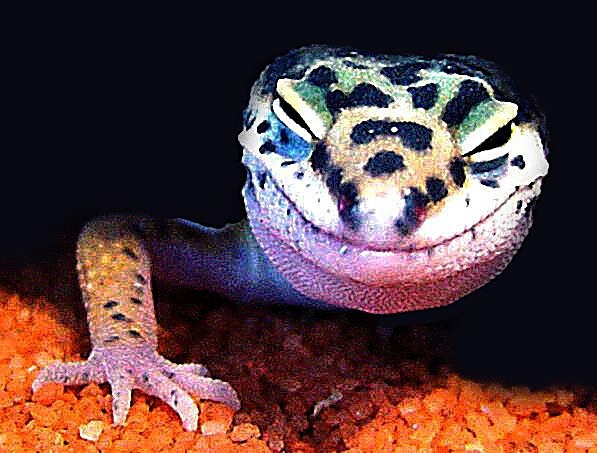 New kingsnake.com classifieds launch Dec. 1 New kingsnake.com classifieds launch Dec. 1
There's a whole new kingsnake in testing now! The new version of the kingsnake website will focus on reptiles and amphibians and the community from a local perspective, with news and events, local breeders and businesses, and, of course, local classified ads broken down by state. The all-new classifieds will be quicker and easier to use, as well as mobile- and tablet-friendly, and will feature a new layout, new search engine friendly URLs for things like individual ads, and a mobile version supporting IOS, Android, BlackBerry, Bada, Windows Phone, palm webOS, symbian, and more. The new classifieds ended beta testing this month, and will launch Dec. 1. Watch for updates!
Year-end housecleaning
We're doing some year-end housecleaning on kingsnake.com , removing or archiving older projects and content, combining some forum and classified ad categories, discontinuing some advertising platforms, and changing the general look and feel of the site while retaining its functionality. Expect to see some changes over the winter break, but plan on kingsnake.com being a leaner, cleaner, faster-loading site come spring!
kingsnake.com advertising sale
kingsnake.com will have a one-week holiday advertising sale starting Friday morning on leaderboard, full, and medium rectangle banners, as well as on storefront/business directory listings and reptile event listings. The sale starts at noon Central Time on Friday, November 9, and will run until noon Central Time on November 16. Banners will be half price, directory listings $100 per year ($50 off), and event listings will be $50 each ($50 off). Watch for the link in kingnsnake.com's header starting Friday, and give your holiday advertising a Christmas goose!
kingsnake.com site coordinator moves on
Longtime staffer and volunteer Cindy Steinle has moved on to other opportunities, and all of us at kingsnake.com would like to wish her success. For many years she has been an important part of our community and our family, and we will miss her. If you have an outstanding kingsnake.com related issue requiring attention please contact us at communityreview@pethobbyist.com.
NRAAC 2013 in Washington, D.C.
Planning has started for the 2013 National Reptile & Amphibian Law Symposium & Workshop, to be held in the Washington, D.C., area. PIJAC and the ARAV have signed on to co-host the event with the National Reptile & Amphibian Advisory Council (NRAAC). Discussions have been opened regarding co-hosting with the Association of Zoos and Aquariums (AZA), Partners in Amphibian and Reptile Conservation (PARC), and the Association of Fish & Wildlife Agencies (AFWA), and so far are looking favorable. Once stakeholder input has been received, it is hoped that a location and date will be determined and announced for the event, probably sometime in early December.
Saturday, November 3 2012
 After years of problems from weather to oil spills, it appears that the Florida Loggerhead nesting numbers are booming!
Loggerhead nesting statewide was almost the highest since monitoring began in 1989, the Florida Fish and Wildlife Conservation Commission said Friday. In total, surveyors counted 58,172 loggerhead nests on the state's “index” beaches, second only to the peak seen in 1998.
Just five years ago, nesting on those same beaches hit a low of 28,074 and prompted widespread concerns about the status of the turtle.
“We're pleased to see this increase, but we recognize that loggerheads, and other sea turtle species, still face many challenges,” Blair Witherington, a commission research scientist, said Friday.
The majority of loggerhead nesting in the United States — 90% — occurs in Florida, especially along the east coast.
The even better news is that nesting season is still going until mid-November. To read the full article, click here.
A group of juvenile Desert Tortoises has been released in Nevada in efforts to track their movements to make relocations more successful in the future.
"Habitat destruction is one of the biggest threats facing desert tortoises in the wild," said Jennifer Germano Ph.D., post-doctoral researcher at the Desert Tortoise Conservation Center. "Currently we are using translocations as an experimental tool to help minimize some of the impacts to tortoise populations. Tracking this group of young tortoises will allow us to better understand how these animals respond to translocation, which will help us improve recovery efforts for this species in the future."
A transmitter has been placed on each of the tortoises to allow researchers to track the movements and health of the juvenile reptiles (ranging in age from 3 to 8 years). Translocations have recently been recommended for tortoises impacted by regional habitat disturbances due to energy project development and as a tool to augment depleted populations. Through this effort, researchers hope to better understand what factors improve long-term survival for individuals and how they can improve the tools they use for the conservation management of this species.
To read the full article, click here.
And last, the grillnet industry is on a course to continue killing sea turtles despite the Leatherback's listing as state marine reptile in California.
Longlining along California’s coast has been banned due its high bycatch of non-target animals, including federally protected marine mammals and endangered species.
The California drift gillnet fishery targets swordfish and thresher shark using nets that stretch a mile in length. But obviously this fishing method collects life indiscriminately from the ocean, resulting in the death or injury (a death sentence in the wild) of more than 130 protected whales, dolphins, seal and sea lions and thousands of other sharks and marine mammals, according to the Sea Turtle Restoration Project.
Anything taken aboard other than a swordfish or shark is dumped back into the ocean – dead, alive or dying.
“Curtains of death, in the form of the California driftnet fishery, should be abolished in California waters and need to be phased out as soon as possible,” biologist and executive director of SeaTurtles.org, Todd Steiner said. “Sea turtles, sharks and whales are all being hammered by this fishery that targets high-mercury seafood species that are largely unfit to eat.”
To read the full article, click here.
Thursday, November 1 2012
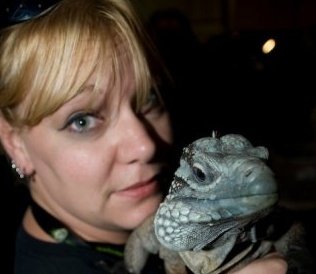 Sometimes we think government regulators are out to get our hobby. But the more I talk with them as individuals, the more I realize some of them simply don't understand how we feel about our pets.
That word -- "pets" -- pretty much sums up the issue, in fact. While I was at the National Reptile and Amphibian Legal Symposium, I had a conversation with one of the US Fish and Wildlife representatives, who had listened to my impassioned comments on general pet owner issues relating to the addition of species onto the Lacey Act. It turns out she was flabbergasted to hear that we reptile people see these animals as our pets, and not as a commodity.
As government regulation and a bad economy combined to threaten the reptile community, we as hobbyists, breeders, and keepers did a pretty good job of talking to our legislators about the financial impact of bans and restrictions. That was a pretty smart thing to do, particularly with more conservative lawmakers who are very attuned to the plight of small businesses.
But we've done a terrible job of talking about how we feel about our animals, and that's hurt us.
Most people who own reptiles keep them as pets, not as a business. It's their beauty and personality, not any prospect of financial gain, that make them important to us.
In my conversation with the regulator, I could see she was really struggling to understand. So I changed "Burmese python" to "cat," and gave her the same scenario. She instantly realized where our passion and anger over the rule change came in. Just in an instant, the realization of leaving behind a beloved pet made all the world of sense.
Reptiles may not be dogs and cats, but to those of us that love and keep them, they are as dear to our hearts. That's something we need to keep talking about.
|


